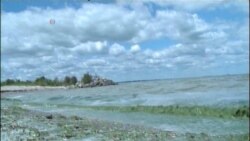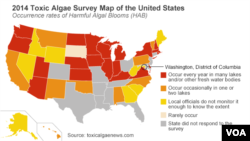This week 400,000 people in Toledo, Ohio, could not drink the water. The city’s water supply was polluted with a toxin linked to the overgrowth of algae. A pea green scum settled over the city’s water intake pipes. For 72 hours the residents relied on handouts of bottled water, which one woman said was stressful. “I have four children and dogs at home," she said, as she picked up free water. “I wanted to make sure we had enough water to brush our teeth and be able to drink it.”
Toledo gets its water from Lake Erie, which is the source of fresh water for 11 million people in the American Midwest.
Algae overload global problem
Lake Erie is by no means unique. Algal overload is common in waterways worldwide caused by fertilizer runoff and poor sewage management. Excessive algae deplete oxygen in the water and kill fish says Laura Johnson, a research scientist at the National Center for Water Quality at Heidelberg University in Tiffin, Ohio.
“It also becomes a problem when the type of algae that are growing is a cyanobacteria that can produce toxins," she said. "And when that happens then we have issues, because then those toxins can be in places like our drinking water, or we can get in contact with it if we’re trying to swim there.”
Toxins can damage the liver and nervous system. Global warming is making the problem worse. Changing weather patterns produce stronger, more intense winds and storms which move more nutrients off the land. Johnson says in Ohio the algal season is a long one.
“The bloom that’s been happening most recently, I mean it’s just started. That’s part of the reason it’s so scary for Toledo right now is because this is the very beginning of the season," she said. "Most of the bloom occurs usually, and gets the largest, in September and October.”
Satellites track algae outbreaks
The National Oceanic and Atmospheric Administration (NOAA) tracks the bloom from space and uses the satellite data to track the bloom and estimate their concentration, says NOAA oceanographer Richard Stumpf. “We can’t tell you if it’s toxic, but we can tell you if it’s there and how much there is.”
This helps alert scientists and public officials to take action. Stumpf says to better manage the problem NOAA is also gathering data on the phosphorous that drives the bloom.
“It’s only the spring phosphorous that creates the bloom in the summer," he said. "Knowing that means that you can now create a strategy for how do you modify fertilizing practices, how do you modify cultivating practices so that the phosphorous stays on the fields, so it stays there and doesn’t run into the rivers and then into the lake.”
Keep nutrients on land
Laura Johnson agrees that the long-term goal must be to keep nutrients on the land. She calls for continued monitoring of farmers' land and water quality. “So that if for some reason a practice is not working as well as we think it should be, then we can change what we are doing and what we are recommending to farmers.”
Advocates for clean water want stiffer controls and greater cash incentives to encourage farmers to adopt best agricultural practices. Farmers balk at tighter regulations and recently saw a reduction in federal funds to address the issue. As the debate continues, one thing is certain. The algal problem is not going away any time soon.









